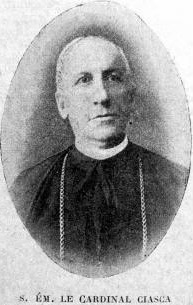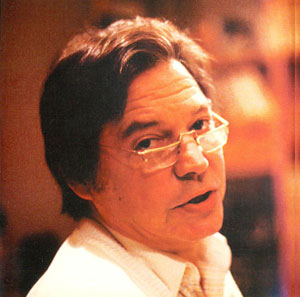Agostino Ciasca
Agostino Ciasca OESA ( born May 7, 1835 in Polignano a Mare, † February 6, 1902 in Rome, civil Pasquale Raffaele Ciasca ) was cardinal.
Life
Pasquale Raffaele Ciasca joined the Congregation of the Augustinian Hermits at March 10, 1856 in, put her profession on March 11, 1857, received on 18 September 1858, the ordination. He visited the monastery of Sant'Agostino in Rome (philosophy and theology ) and the Monastery of Santa Monica ( Greek and Hebrew fonts for eight years ). He received his doctorate in theology and Hebrew.
Leo XIII. entrusted him with some difficult missions. In his order he was, except that he was a professor of dogmatic theology, Sacred Scripture and Oriental Languages , Prefect of Studies, Assistant General and then Attorney General.
In 1866 he received the chair of Hebrew at the Pontifical Collegium Urbano de Propaganda Fide and later he participated in the First Vatican Council as theologian, and interpreter for the Oriental bishops in part. He also occupied the following positions: consultant to the Congregation de Propaganda Fide for the affairs of the Eastern rites (1872 ); Clerk in the Vatican Library for Arabic ( 1876); Interpreter in the Congregation de Propaganda Fide, usually censor the oriental books and professor of Oriental languages in the Roman Seminary (1878 ); Dean of the faculties of theology and oriental languages in the same seminar, and President of the Quorum of the interpreter in the Congregation de Propaganda Fide (1882 ) and consultant to the Holy Office (1889 ).
The Pope appointed him on 1 June 1891 Titular Archbishop of Larissa in Syria. He received his episcopal consecration of the Cardinal Secretary of State, Cardinal Rampolla Mariano del Tindaro, on 7 June of the same year in Rome. In the same year he was sent by the Holy See to Lviv to have presided over the Ruthenian Synod held. On September 19, 1892 he was appointed Pro- Secretary of the Congregation de Propaganda Fide and collected on June 19, 1893 Secretary. Leo XIII. took him on 19 June 1899 as cardinal priest in the Sacred College, and he received on 22 June of the same year, the titular church of San Callisto. After lying in state in the Basilica of Sant'Agostino, his body was buried in the chapel of his order at the cemetery Campo Verano. On April 28, 1938, his remains were transferred to the church of Santa Maria del Popolo.
Works
He published (1885-1889) preserved fragments of a very old Coptic Version of the Old Testament from manuscripts of the Borgia collection in the Museo Propaganda Fide in Rome. He discovered and edited (1888 ) a Arabic version of Tatian's Diatessaron, a text of importance for the history of the canon of the New Testament ( cf. M. Maher, Recent Evidence for the authenticity of the Gospel: Tatian 's Diatessaron, London, 1903).
His own principal works are:
- Examination critical Apologeticum Super constitutionem de Fide Catholica Dogmaticam editam in Sessione tertia SS Oecumenici Concilii Vaticanii ", 270 pages 8vo (Rome, 1872)
- I Papiri Copti del Museo della Borgiano SC de Propaganda Fide tradotti e commentati, pamphlet of 55 pages (Rome, 1881)
- Sacrorum Bibliorum Framenta Copto - Sahidica Borgiani Musei, vol. I, 225 pp. 4to, with 8 plates ( Rome, 1885 and 1889 ). These two volumes deal with the Old Testament; vol. III, dealing with the New Testament (509 pages with 40 plates ) was established in 1904 by PJ Balestri published ..
- Tatiani evangeliorum Harmoniae Arabicae nunc primum ex duplici codicae editIT et Latina translatione donavit ... in 4to, 108 pages (Rome, 1888).





.jpg/220px-His_Excellency_Mgr._Falconio._Photo_C_(HS85-10-11509).jpg)




